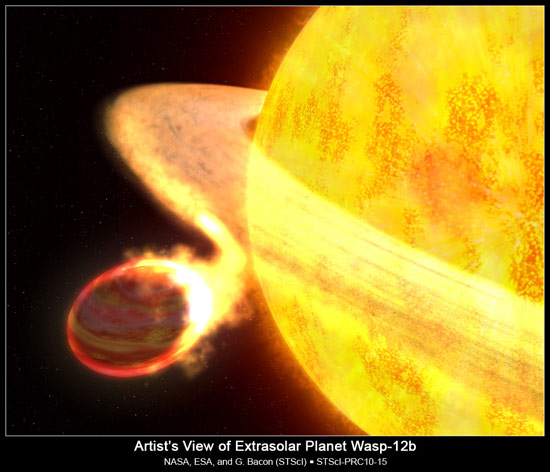The hottest and fastest planet
Astronomers have discovered a special planet among known planets so far. It is named WASP-12b and the character of this object is the fastest, hottest and closest to a fixed star.
The planet WASP-12b is about the size of Jupiter, but it is closer to its fixed star than the distance between the Earth and the Sun by 40 times. That closeness makes it move very fast, completing a rotation just a little over 25 hours. Previously, it was thought that the planet could not be so close to the Mother Star, but the Universe always proved that it did not need to know the hypotheses that scientists had made.

WASP-12b is very close to its fixed star. (Photo: Superwasp)
The planet's proximity to the Star causes it to heat up to very high temperatures. The surface temperature of the planet is up to 2,250 degrees Celsius - which is only half the temperature of the Sun's surface and is equivalent to the temperatures of individual stars not as hot as Red dwarfs. This remarkable planet was discovered by British astronomer Lesley Hebb and Saint Andreas University colleagues while studying 'Wide Wide Angle Search' - Super Wide Angle ( SuperWASP abbreviation, the name of the planet we refer to by this phrase). Hebb's research has used two very powerful telescopes in Spain and South Africa to track the brightness of distant stars, to know when there are planets flying past them. Watching from the ground, will see at that time, the stars darken.
It is hard to imagine that it is possible to calculate the temperature and speed of planets based solely on the reduction of the brightness of stars, but it is clear that Mathematics always creates miracles. Researchers have confirmed they can identify these two quantities when comparing the parameters of fixed stars and planets.
The planet they discovered attracted the attention of scientists at extraordinary speed and a close proximity to the parent star, which was never observed. The planet similar to it is Jupiter in the solar system which is thousands of times away from the Sun. Now astronomers are looking for ways to explain how a planet can form and survive, despite conditions that were previously acknowledged by people.
Another thing that the researchers have to explain is that the process of the planet " eats " the materials that the " throw " star is mostly metal, unlike Jupiter in gaseous form, so it is very heavy and need to have the inertia needed to keep it still flying without falling into the star when the distance is so close.
- Find the hottest planet ever
- The 9 hottest places on the planet are still inhabited
- Discover the hottest planet
- Ten strange planets of the universe
- The hottest places on the planet
- Planet is more than 4,000 degrees Celsius in the universe
- Which animal is the fastest on the planet?
- The secret of the fastest runners of the planet
- 12 hottest things in the universe
- July 2015 is the hottest month in 200 years
- Interesting things about the solar system
- Reveal the list of the 7 most massive
 Van Allen's belt and evidence that the Apollo 11 mission to the Moon was myth
Van Allen's belt and evidence that the Apollo 11 mission to the Moon was myth The levels of civilization in the universe (Kardashev scale)
The levels of civilization in the universe (Kardashev scale) Today Mars, the sun and the Earth are aligned
Today Mars, the sun and the Earth are aligned The Amazon owner announced a secret plan to build a space base for thousands of people
The Amazon owner announced a secret plan to build a space base for thousands of people NASA's 'Ninth Planet' Shows Signs of Being Friendly to Life
NASA's 'Ninth Planet' Shows Signs of Being Friendly to Life  Which planet is the oldest and youngest in the Solar System?
Which planet is the oldest and youngest in the Solar System?  Breakthrough discovery of planet with more water than Earth
Breakthrough discovery of planet with more water than Earth  How would humans die when visiting other planets?
How would humans die when visiting other planets?  Habitable planet appeared next to Earth, but met with disaster
Habitable planet appeared next to Earth, but met with disaster  Chinese spacecraft discovers mysterious cubes on other planets
Chinese spacecraft discovers mysterious cubes on other planets 